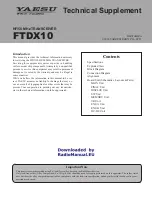
Page 11 of 90
CCT24
packet sequence number and error checking bytes to the data when it is transmitted. These additional
bytes are not output at the remote in transparent mode. The sequence number is used in acknowledging
successful transmissions and in retransmitting corrupted transmissions. A two-byte CRC and a one-byte
checksum allow a received transmission to be checked for errors. When a transmission is received by the
remote, it will be acknowledged if it checks error free. If no acknowledgment is received, the base will
retransmit the same data on the next hop. Note that acknowledgements from remotes are suppressed on
broadcast packets from the base.
In point-to-point operation, by default a remote will send the data in its transmit buffer on each hop, up to
the limit controlled by its
RemoteSlotSize
parameter. If desired, the
MinPacketLength
and
TxTimeout
parameters can be set above their default values, which configures the remote to wait until the specified
amount of data is available or the specified delay has expired before transmitting. In transparent mode, if
the remote is buffering more data than can be sent on one hop, it will send the remaining data in subse-
quent hops. The remote adds its own address, a packet sequence number and error checking bytes to
the data when it is transmitted. These additional bytes are not output at the base if the base is in trans-
parent mode. When a transmission is received by the base, it will be acknowledged if it checks error free.
If no acknowledgment is received, the remote will retransmit the same data on the next hop.
2.8.2 Point-to-Multipoint Network Operation
In a point-to-multipoint network, the base is usually configured for protocol formatting, unless the applica-
tions running on each remote can determine the data’s destination from the data itself. Protocol formatting
adds addressing and other overhead bytes to the user data. If the addressed remote is using transparent
formatting, the source (originator) address and the other overhead bytes are removed. If the remote is
using protocol formatting, the source address and the other overhead bytes are output with the user data.
A remote can operate in a point-to-multipoint network using either transparent or protocol formatting, as
the base is the destination by default. In transparent operation, a remote CCT24 automatically adds
addressing, a packet sequence number and error checking bytes as in a point-to-point network. When the
base receives the transmission, it will format the data to its host according to its formatting configuration.
A remote running in transparent mode in a point-to-multipoint network can have the
MinPacketLength
and
TxTimeout
parameters set to their default values to reduce latency, or above their default values to re-
duce the volume of small packet transmissions.
2.8.3 Multipoint Peer-to-Peer Network Operation
After a remote has joined a point-to-multipoint network, it can communicate with another remote through
peer-to-peer messaging, where the base acts as an automatic message relay. In protocol mode, if a
remote specifies a destination address other than the base address, peer-to-peer messaging is enabled.
In transparent mode, the
RmtTransDestAddr
parameter sets the destination address. Changing
Rmt-
TransDestAddr
from the default base address to the address of another remote enables peer-to-peer
messaging. The broadcast address can also be used as a peer-to-peer destination address. In this case,
the message will be unicast from the remote to the base (using ARQ) and then broadcast by the base (no
ARQ). For peer-to-peer broadcasts, no acknowledgement is sent and no
TxDataReply
packet is reported
to the host.












































